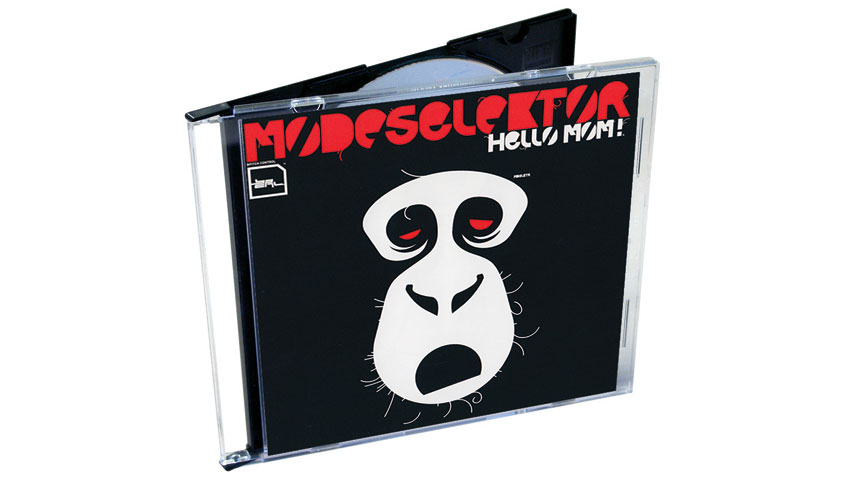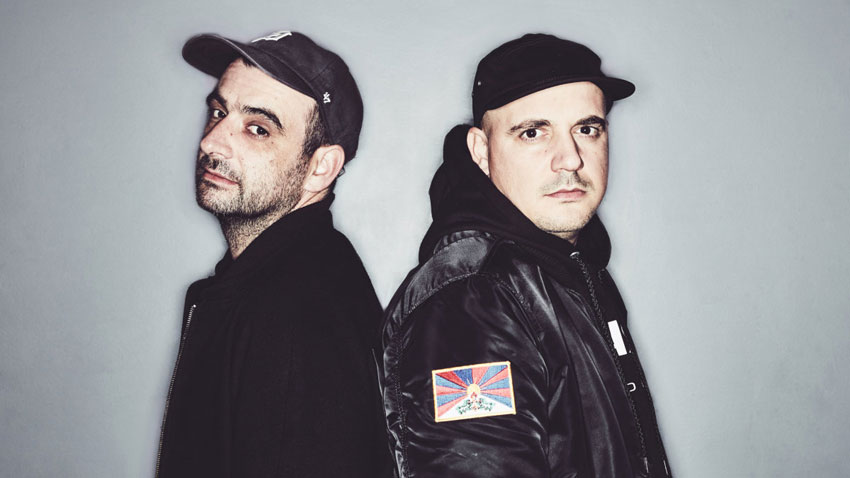Classic album: Modeselektor on Hello Mom!
The Berlin production duo look back at their seminal techno debut

Back at the dawn of the new millennium, thriving art communities took root in downtown Berlin as they’d done for decades. This was before the heavy hand of gentrification swooped in and flicked all the weirdoes and musicians out.
You could live in a big old building with likeminded nutters and make beautiful music for a pittance. “That’s what we did,” says Gernot Bronsert of Modeselektor. “Now it’s not affordable anymore. If you want to buy a flat there it’s around €10,000 for a square meter. Back then we paid, like, 150 bucks a month!”
Gernot, along with Sebastian Szary, hunkered down in this cheap and cheerful little world and made the beats that would wind up on their absurd and nevertheless engaging, grime-laced techno debut, Hello Mom!.
Gernot would come home after a shift at Hard Wax records, ears ringing with current club shenanigans, and find Szary cooking up next-level sounds on their makeshift studio setup.
“We had some classic techno gear,” says Sebastian. “And, because we had no money, things we found on the street like these old JBL speakers. They had no bass so we cranked all that up. It made the whole album sound really heavy. There was no real plan. It was just punk - y’know?”
Whatever it was, you could boogie to it. And that was the point. The so-called ‘Intelligent Dance Music’ of the day had forgotten one thing. “For us it was not danceable enough,” says Gernot. “So we always tried to do that with this album.”
They sidestepped the clichés, let the randomness of their machines take some of the creative weight, and laced the tracks with fizzing ideas and chance collabos with friends.
Get the MusicRadar Newsletter
Want all the hottest music and gear news, reviews, deals, features and more, direct to your inbox? Sign up here.
“It was a great time,” says Gernot. “We’d never made an album before. This was kind of pre-internet. No YouTube tutorials. There was MySpace going on, but everything took ten times longer. It was nicer, because we were more relaxed back then. And you can hear that on the album.”
And what an album it is! Here, Gernot and Sebastian take us through Hello Mom! track by track.

Dancingbox
Gernot Bronsert: “I used to work in a record shop called Hard Wax, and one day the French rap group TTC came in looking for one of our records. I was proud as fuck that someone would ask me without knowing I was 50% of the group.
“We became friends, and we sent them this beat. The funny thing is, we don’t speak any French, so we just took all their words and used them as a rhythmic element, cutting up the vocals with the music. We didn’t take any care of the sense of their words [laughs]. It became a little hit in France. It was our first step into French club culture. TTC sold out big venues. They were not techno guys. They were just interested in our crossover sound.”
Die Clubnummer
Sebastian Szary: “Do you know what the meaning of the title is? It’s a joke about making a song especially for the club.”
GB: “We released this album on BPitch Control, which is run by Ellen Allien, and she always wanted usable club tracks on the label. We just wanted to piss her off a little bit, delivering her a track like this, called Die Clubnummer [laughs]. It ended up being big, though. The people seemed to like it a lot.
“This track itself is the result of searching for the perfect 303 clone. It’s also pretty IDM-ish and acid-influenced. The bass comes from Native Instruments’ Reaktor. At this time we started discovering the user library. We had some guys that made some nice patches that we used.”
Tetrispack
GB: “We came across the sound that makes up the main part of the track by accident. It was something that was left over when I started using a Pluggo sampler. You know it? Max/MSP had this software company and they released some granular plugins.
“Granular back then was the hot shit to use. Today, all the young guns are totally into using hardware on the stage, you know? But back then it was super cool to use complicated plugins and software [laughs].
“I tried to use one of these plugins, but I couldn’t handle it! Luckily I was recording the whole time, and got the sounds that we ended up making the track with.”
The Rapanthem
SS: “We made this one just for fun. The idea for the backing beats came from part of a DJ mix we did in 2004 for Boomkat [Boomkat Selected Mixtapes Volume 4]. It was full of great beats that inspired this track.
“We edited that mix together in Logic - we didn’t mix it with vinyl, or in Ableton like you might do today. And as we were making it, track by track, there was this moment with this great loop in it. As we looped it, Gernot had this melody, this sound of the melody, and he put it in, and the track came to life. So, that’s the secret of the track.”
GB: “I don’t know which version you are using for this, but I think the vinyl version of this track is more explicit than the digital version.”
Kill Bill Vol 4
GB: “I believe this was a two-year process. We tried to work on it in several different places. We didn’t have the proper studio with nice acoustics, so we moved to have a better chance of mixing it right. We just wanted to listen to it in different circumstances and surroundings.”
SS: “Definitely different circumstances.”
GB: “Yes. We smoked a lot of weed back then [laughs]. We finished it in my sister’s basement while we house sat. The problem with that space was its resonance - we couldn’t listen to the track too loud. Which, in the end, was a good thing.”
SS: “We toured for 12 months as DJs and found that this track was louder than everything else we played. So we did a good job on this one.”
We toured for 12 months as DJs and found that this track was louder than everything else we played. So we did a good job on this one.
Ziq Zaq
SS: “The real aim behind making this track was to use a 707 drum set [laughs]. This Roland drum machine had a very short kick and snare to it, which we were going for. The aim was to make an electro-ish track using that sound.
“Some days you have an idea. Like, ‘Hey! Let’s try this’. It was very simple, with a positive bassline. It’s not a sad track - it’s a positive track.
“Also, it’s called Ziq Zaq because we toured a lot, back and forward. It was like we were zigzagging across Europe back then.
“There are cool sounds in there from a resonated MC-202, as well, also from Roland.”
Vote Or Die
SS: “This was around the time of the US election, with Bush number two. It was when all the American artists started the ‘Vote or Die’ campaign.”
GB: “This track is also based on a Reaktor sound. It was another one we made very quickly. We made it mostly on tour, around the end of 2004.”
SS: “We had another project together with the video/designer collective, Pfadfinderei. We toured a lot with them. We have an audio/visual side project with them called Labland, and parts of this track were parts of that show. It was only for the show. We never made a track out of it before.”
GB: “A lot of ideas came up while we were touring.”
Earth (UPS edit)
GB: “This track was made for an audio/visual installation, which is still a permanent exhibition in Paris in the Centre Pompidou, which is kinda like the national gallery. We made it with the Pfadfinderei guys. The idea of the project was based around showing the four elements. And our part was earth. You can go in and watch all the images whilst listening to this track.”
SS: “It’s based on samples that we made from stones.”
GB: “On YouTube you’ll find a video of the crunching of stones we used.”

Fake Emotion
GB: “This track is very much influenced by our roommate back then - Tadd Mullinix, aka Dabrye. He’s from a little city near Detroit and releases music on the Ghostly International label, which he co-runs. He also records as James T Cotton, and does other diverse projects. The music he produced back then was pretty much hip-hop. When he lived in our house, for a year or so, he released a record with Jay Dee on Ghostly. The beat for Fake Emotion was inspired by that.
“We made this beat back then when we were listening to a lot of instrumental J-Dilla stuff, too.”
SS: “Then we gave the track to Tikiman, aka Paul St Hilaire, and he made the vocals for it. He’s a mysterious man.”
Hasir
GB: “Hasir was the name of a Turkish restaurant just around the corner from us that only served meat. ‘Vegetarians: use side door’ [laughs]. We named the track after it.”
SS: “We had to be lucky in the writing process. We couldn’t control all the sounds. We didn’t work by having an idea in mind and going to the studio and recording and finishing it. It was 100% trial and error, all the time, you know?”
GB: “The drums on this got created with a little help from a guy called Matt Shadetek. He was a friend of ours from New York who lived in Berlin. He released his first album as Team Shadetek on Warp Records that year. He shared our studio. He was like our studio roommate and we shared beats and stuff.”
Silikon
GB: “This is a collaboration between us and Sasha Perera, who was the singer of Jahcoozi, a Berlin band. She’s from Sri Lanka, but grew up in the UK, and came to Berlin. Berlin is little. When you’re on the scene you know everyone. She wrote her parts after we gave her the music. We always work by writing the beat first, and then see what’s going on.”
SS: “Like TTC, we recorded the vocal, then we put it in our Max/MSP patch, with a ‘random’ function. It totally mixed her words up. There is no content in that part, really. But you can find some sub-content [laughs]. The voice is an instrument.”
I Love You
GB: “To tell the truth, this is made from a preset sequence from a Reaktor ensemble. We found out that two more people in the coming years used that preset sound, so it was the first and the last time we used that [laughs]. It ended the album perfectly, though.”
SS: “We were surprised about how this album came out - that everything made sense together.”
GB: “When I look back at pictures of this time it feels so long ago, man. This album was the start of everything for us, and our so-called career.
“The good thing is that I do not feel ashamed of any of these tracks, which doesn’t happen very often.”
SS: “We never made a track, finished it, and never released it. Everything we started work on came out here. There are no leftovers.”
Check out the latest Modeselektor single I Am Your God / Bronko at Monkeytown Records.


Future Music is the number one magazine for today's producers. Packed with technique and technology we'll help you make great new music. All-access artist interviews, in-depth gear reviews, essential production tutorials and much more. Every marvellous monthly edition features reliable reviews of the latest and greatest hardware and software technology and techniques, unparalleled advice, in-depth interviews, sensational free samples and so much more to improve the experience and outcome of your music-making.
"At first the tension was unbelievable. Johnny was really cold, Dee Dee was OK but Joey was a sweetheart": The story of the Ramones' recording of Baby I Love You
"Reggae is more freeform than the blues. But more important, reggae is for everyone": Bob Marley and the Wailers' Catch a Fire, track-by-track










